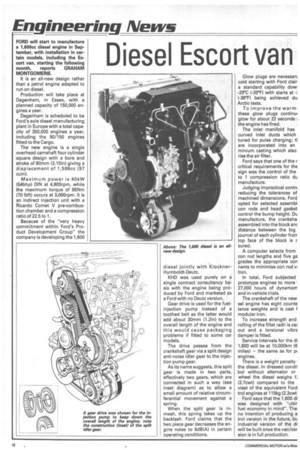Diesel Escort van
Page 20

If you've noticed an error in this article please click here to report it so we can fix it.
FORD will start to manufacture a 1,600cc diesel engine in September, with installation in certain models, including the Escort van, starting the following month, reports GRAHAM MONTGOMERIE.
It is an all-new design rather than a petrol engine adapted to run on diesel.
Production will take place at Dagenham, in Essex, with a planned capacity of 150,000 engines a year.
Dagenham is scheduled to be Ford's sole diesel manufacturing plant in Europe with a total capacity of 350,000 engines a year, including the 90/150 engines fitted to the Cargo.
The new engine is a single overhead camshaft four cylinder square design with a bore and stroke of 80mm (3.15in) giving a displacement of 1,598cc (97 cu in).
Maximum power is 40kW (54bhp) DIN at 4,800rpm, while the maximum torque of 95Nm (70 I bft) occurs at 3,000rpm. It is an indirect injection unit with a Ricardo Comet V pre-combustion chamber and a compression ratio of 22.5 to 1.
Because of the "very heavy commitment within Ford's Product Development Group" the company is developing the 1,600 diesel jointly with KlocknerHumboldt-Deutz.
KHD was used purely on a single contract consultancy basis with the engine being produced by Ford and marketed as a Ford with no Deutz version.
Gear drive is used for the fuelinjection pump instead of a toothed belt as the latter would add about 30mm (1.2in) to the overall length of the engine and this would cause packaging problems if fitted to some car models.
The drive passes from the crankshaft gear via a split design anti-noise idler gear to the injection pump gear.
As its name suggests, this split gear is made in two parts, effectively two gears, which are connected in such a way (see inset diagram) as to allow a small amount of relative circumferential movement against a spring.
When the split gear is inmesh, this spring takes up the backlash. Ford claims that the two piece gear decreases the engine noise to 6dB(A) in certain operating conditions.
Glow plugs are necessar) cold starting with Ford clair a standard capability dow; -29°C (-20°F) with starts at -: (-36°F) being achieved du Arctic tests.
To improve the warm• these glow plugs continur glow for about 22 seconds ; the engine has fired.
The inlet manifold has curved inlet ducts which tuned for pulse charging; tl are incorporated into an minium casting which also ries the air filter.
Ford says that one of the r critical requirements for the sign was the control of the to 1 compression ratio du manufacture.
Judging impractical contr( reducing the tolerances of machined dimensions, Ford opted for selected assembl con rods and head gasket control the bump height. Du manufacture, the cranksha assembled into the block anc distance between the big journal of each cylinder frorr top face of the block is r sured.
A computer selects from con rod lengths and five ga grades the appropriate con nents to minimise con rod v. ti on.
In total, Ford subjected prototype engines to more 27,000 hours of dynamonr and in-vehicle trials.
The crankshaft of the new sel engine has eight counte lance weights and is cast f modular iron.
To increase strength and rolling of the fillet radii is car out and a torsional vibra damper is fitted.
Service intervals for the di 1,600 will be at 10,000km (6 miles) — the same as for pr engines.
There is a weight penalty the diesel. In dressed condil but without alternator or wheel the diesel weighs 1: (2.7cwt) compared to the viest of the equivalent Ford trol engines at 115kg (2.3cwt Ford says that the 1,600 di was designed with "ultir fuel economy in mind". The no intention of producing a trol version in the future, bu industrial version of the di will be built once the van/car sion is in full production.
















































































































